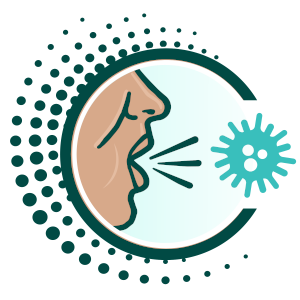Background and mission of the program
CoughWatchSA is a participatory surveillance program developed by the Centre for Respiratory Diseases and Meningitis from the National Institute for Communicable Diseases. Our aim is to conduct surveillance for communicable respiratory diseases within South Africa in order to provide data on the burden, severity and seasonality.
Our mission is to develop a real-time surveillance program for non-medically attended cases of influenza-like illness (ILI) as reported by members of the community. We want to systematically collect data on health-seeking behaviour, vaccination coverage and trends of reported suspected cases of ILI. In so doing, we hope to develop an early warning system for identifying suspected cases of ILI directly from the community, without needing a visit to a clinic or hospital. Our data will complement existing facility-based surveillance programs to better understand the broader community burden of respiratory illness.
Team members and their roles
CoughWatchSA study teams consist of staff from the Centre of Respiratory Diseases and Meningitis at the National Institute for Communicable Diseases, a division of the National Health Laboratory Service in South Africa. The team includes collaborators from the Centre for Disease Control (CDC) Atlanta in the United States of America, the World Health Organisation Geneva, the Institute for Scientific Interchange — in Italy and Epicentre from South Africa
Study Team | |
|---|---|
Mr Mvuyo Makhasi | Study Lead |
Prof Cheryl Cohen
| Centre Head
|
Dr Sibongile Walaza
| Epidemiology Head
|
Prof Anne von Gottberg
| Laboratory Head
|
Dr Jocelyn Moyes
| Home-based testing Lead
|
Communications Team | |
|---|---|
Mr Vuyo Sabani | Acting Senior Communications Manager |
Ms Nande Harmans | Editorial Specialist |
Mr Athenkosi Mjobo | Graphic Designer |
Siyabonga Mbatha | Web Content Specialist |
External Collaborators | |
|---|---|
Prof Stefano Tempia | World Health Organisation – Geneva |
Dr Daniela Paolotti | Institute for Scientific Interchange – Italy |
Dr Aaron Samuels | Centre for Disease Control Atlanta – USA |
Cherie Cawood | Epicentre |
Laboratory | |
|---|---|
Dr Mignon Du Plessis | Principal Medical Scientist |
Mrs Fahima Moosa | Senior Medical Scientist |
Ms Noluthando Duma | Medical Technologist |
Ms Thulisile Nkabinde | Laboratory receiving clerk |
Data Team | |
|---|---|
Siyabonga Mazibuko | Laboratory Database Administrator |
Phiwokuhle Ntombela | Study Data Coordinator |
Program's achievements and impact
The first pilot of CoughWatchSA was launched on 9 March 2022 and received a widespread interest from the media, and members of the local and international community. The aim of the launch was to pilot the methods of digital participatory surveillance and assess the acceptability and feasibility of using this program for respiratory illness in South Africa. The second object was to assess the feasibility of linking eligible participants to home-based testing for influenzas and COVID-19.
We reached 954 volunteers who accessed the platform, and 249(26%) successfully enrolled in the study. A majority of the enrolled participants were women 178(71%) and the largest age group was 30-39 years 93(37%). Among enrolled participants, 62(25%) reported seasonal influenza vaccine receipt in 2022 and 212(85%) had received at least 1 dose of COVID-19 vaccine. We received a total of 1440 symptom reports over 29 weeks of deployment, with an average of 50 weekly symptom reports submitted. We were able to determine 31(2%) and 110(8%) suspected ILI cases with and without fever, respectively. We determined 359(25%) suspected COVID19 cases overall. Due to small enrolment numbers and inconsistent participation, we could not determine a significant correlation between reported data from CoughWatchSA and laboratory data. A total of 88/249(36%) participants were eligible for home-based testing, and 81/88(92%) were successfully enrolled. We detected 6/81(7%) influenza and 26(32%) SARS-CoV-2 infections
Although the number of enrolled individuals was low, the study demonstrated the potential of obtaining data on non-medically attended ILI and COVID-19 cases. The platform has the potential to provide good vaccine coverage data for seasonal influenza and COVID-19. Linkage to home-based testing was successful and demonstrates the potential for self-swabbing and real-time detection of influenza and COVID-19. This platform could complement sentinel surveillance to provide a better estimate of the community epidemiology of respiratory illness. Our aim this year is to polite a new platform using a web application and attract and retain more participants to strengthen the value of this surveillance program.

